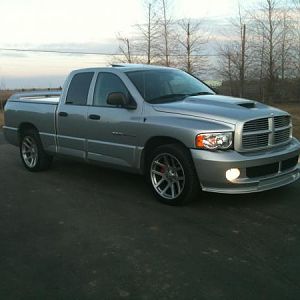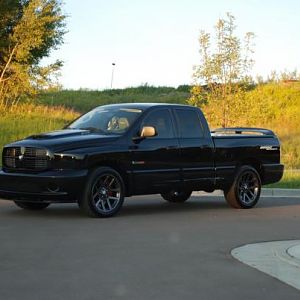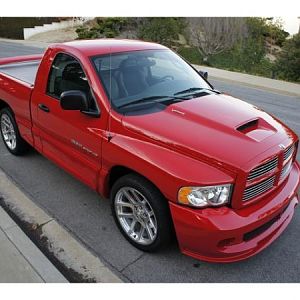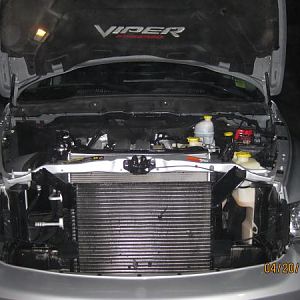looks great man... that color goes great with black.. I did almost the same color on my jeep srt8 engine bay
You are using an out of date browser. It may not display this or other websites correctly.
You should upgrade or use an alternative browser.
You should upgrade or use an alternative browser.
Just got custom cam and powder coat from JMB!
- Thread starter badRAMbake
- Start date
badRAMbake
New Member
- Joined
- Jan 1, 2010
- Messages
- 20
- Reaction score
- 0
NukeGM/Ford
Active Member
NukeGM/Ford
I searched for a LONG writeup I did on camshafts years ago on this site but I could only go back to 2011. Here is an abbreviated version...
DURATION numbers are now measured from .050" lift. There are a few manufacturers using a different number but .050" is relatively common.
Prior to standardizing, duration numbers didn't make any sense so measuring from .050" really helped in making an informed decision when choosing or designing your own cam.
So, your old BB Charger cam very likely WASN'T 284/295 duration at .050" lift. It was strictly an advertised (nearly meaningless number) before the .050" lift standardization came around.
Sidebar: As there are 360 degrees in a circle, if a camshaft had 360 degrees duration the valve(s) would never close! That wouldn't work.
Sidebar: Camshafts should be chosen based on the cylinder heads ability to flow. There is a common misconception here that the more the heads flow, the more power the engine is going to make. This is NOT true and is a whole other topic.
Anyway, the Intake and exhaust valves have to open and close at the "right" time for the engine to run. Juggling Duration for example (the length of time they are open measured in degrees) will change how long the valves are open. Intake and Exhaust can be different here, You might want a cam ground with 225 duration on your Intake and say 235 on your Exhaust (if for example, the cylinder head has a lame exhaust port). Leaving the Exhaust Valve open longer may help here.
The Intake valve closing point is really important as the mixture does not start to get compressed until the Intake closes.
OVERLAP is when BOTH the Intake and Exhaust valves are open and is also expressed as Lobe Separation Angle or L.S.A. It happens right near the end of the Power Stroke when the piston is still going down. The Exhaust Valve stays Open a specific length of time (based on Overlap, or L.S.A.); to assist the incoming charge behind the the now Opening Intake valve (the piston is now on its way back up on the Exhaust Stroke).
The LOWER the L.S.A. number (say a 108 vs. a 120) the more overlap the the cam is going to have. The overlap is going to largely dictate the amount of boogity-boogity sound the engine has at idle and where (r.p.m. range) the power is going to be applied. GENERALLY, the more overlap the cam has, the peakier and narrower the power band will be. It makes that sound because the intake charge is actually getting pushed backwards into the Intake Manifold because there is not yet enough engine r.p.m. (at idle) to encourage Intake flow in the right direction. That is why the boogity-boogity sound stops and the engine starts to run smoothly and make power once the r.p.m. is high enough.
Overlap is closely tied/ground with duration so you couldn't order a cam with lots of overlap (to get that "sound") and leave everything else stock.
Power (Torque) is cylinder pressure, period. So if you start with an engine with a low compression ratio and install a camshaft with a late closing Intake Valve (lots of Duration), there isn't much left to compress. The engine will be a nice sounding dog.
Remember I said nothing starts to compress until the Intake Closes?
Well, if you have an engine that is say a Viper engine and you put a really rank cam in it without increasing the compression ratio by milling heads, or changing pistons, there are going to be issues with that engine. It will likely have a nice sound, less than optimum gas mileage, and not a lot of torque at low r.p.m. where you need it in a truck. That is why a rank cam and an increase in compression should be done together. Some guys just want the "sound" and don't care about the rest. I'd choose a camshaft that builds Torque over horsepower, particularly in a heavy truck like the SRT-10.
LIFT is how high the valves are lifted off of their seats. It can also be different between the Intake and Exhaust Valves.
So, the comment before about the Cylinder Head and Camshaft relationship...
If your heads quit flowing at .450" lift, there isn't much point in punishing your street engine's valvetrain with a cam that lifts to .650".
Camshaft choice is best left to those selling cams. They will (should) ask you a bunch of questions about your engine, compression ratio, gearing, ported heads, WEIGHT, bore, stroke, valve sizes, converter, INTENDED USE, etc.
The vast majority of the time you are in your street vehicle you will be a something less than wide open throttle so you have to use some common sense when choosing a cam.
Just like heads, bigger cam numbers will not automatically mean more power.
Torque and Horsepower are often on a see-saw when changing engine parts; If one goes up, the other goes down. I tell customers if you can't choose between a Big Cam and a Slightly Smaller Cam, choose the smaller one.
Changing a camshaft will change how and where your engine will make it's power.
This topic can get quite involved, I hope the above info was clear enough to help you out a bit.
If you have some specific question(s), I will try to answer.
But, talk to trusted Vendors on this site and (if you can) people that are using their products to see if they got the results they wanted. There are some happy customers in the posts above...
I wanted it all for my own truck: Really good (useable) Torque, high r.p.m. horsepower AND really good gas mileage.
So, I tweaked the numbers until I thought it would work with my particular combo.
And (3) cams later, I am happy with the results, even though I didn't get it all, it was really close!
It's a cool science.
Have fun...
Ronnie
well, i should of said i know some basics…… but anyway, i was thinking the advertised duration was at .050 but it wasn't, duration at .050 was .248, so a lot closer just not what i thought a performance vehicle would have. thanks though
well, i should of said i know some basics…… but anyway, i was thinking the advertised duration was at .050 but it wasn't, duration at .050 was .248, so a lot closer just not what i thought a performance vehicle would have. thanks though
No problem, I had a really good cup of coffee going and some time on my hands to use my (2) fingers to type a small novel.
248 degrees @.050 is getting large('ish) in an engine with a displacement of only 383 cubes. They had a fairly short 3.38" (well, 3.375") stroke and cam choice was a biggie with the 383s.
Did it make decent power in the Charger?
The old cam I had in the 505 was only a 226 on a wide 114 (great Nitrous Cam) and produced good torque (great for the QC).
Last edited:
No problem, I had a really good cup of coffee going and some time on my hands to use my (2) fingers to type a small novel.
248 degrees @.050 is getting large('ish) in an engine with a displacement of only 383 cubes. They had a fairly short 3.38" (well, 3.375") stroke and cam choice was a biggie with the 383s.
Did it make decent power in the Charger?
The old cam I had in the 505 was only a 226 on a wide 114 (great Nitrous Cam) and produced good torque (great for the QC).
So what size cam would you recommend for a 6 speed qc?
You are showing "New Build In Process" in your sig so talk to a site vendor to give him the build details (if it is the engine you are working with here). Personally, I'd still go for a camshaft that builds torque which is what the 505 was originally designed around with relatively small valve sizes, ports, etc.
No point in forcing an engine with a 97 pound crankshaft to buzz to make power if you don't have to.
These trucks are heavy and push a lot of air.
Ballpark numbers:
Duration- Somewhere in the 225-235 range. (Upper range: Use with more compression)
Lift- .600+ range (depends on head work)
LSA- 114 range
Staying in the above range, you can expect a chunky idle, decent gas mileage, a cam that won't trip check engine lights and nice linear power with lots of torque.
Keep in mind, these numbers can't reflect the whole cam-lobe profile story.
As you likely know, there is no ONE miracle cam that will work better than all the rest.
That's why I'm still suggesting a consult with a knowledgeable, proven Vendor, as I have no idea what your big picture is here...
Good Luck.
No point in forcing an engine with a 97 pound crankshaft to buzz to make power if you don't have to.
These trucks are heavy and push a lot of air.
Ballpark numbers:
Duration- Somewhere in the 225-235 range. (Upper range: Use with more compression)
Lift- .600+ range (depends on head work)
LSA- 114 range
Staying in the above range, you can expect a chunky idle, decent gas mileage, a cam that won't trip check engine lights and nice linear power with lots of torque.
Keep in mind, these numbers can't reflect the whole cam-lobe profile story.
As you likely know, there is no ONE miracle cam that will work better than all the rest.
That's why I'm still suggesting a consult with a knowledgeable, proven Vendor, as I have no idea what your big picture is here...
Good Luck.
Last edited:
ralphie
Full Access Member
- Joined
- Nov 21, 2011
- Messages
- 250
- Reaction score
- 2
I just(about a month ago) had Justin do a Cam/dyno on mine and absolutely love it. Couldnt have asked for anything better. Fast service and very personable..! Specs Adv Dur 282/287...@ 50 233/237 Lift 593/585 ..Sep 113
Last edited:
VENOMOUS1 RACING
Has Left the Room - Banned from VTCOA!
So what size cam would you recommend for a 6 speed qc?
Like Ronnie said many details would be needed. Are you still planning to boost, spray? NA? Track numbers? DD torque? Future mods? You can always sell a used cam that's in good comdition but I recommend setting a goal and following the path to get you there. Depending on power adder or NA, compression both static and dynamic, and as Ronnie also said, head work, the cam makes all the difference. You can assume there can be around 45 whp or so difference on a nitrous cam vs and all out NA cam, but the nitrous cam will shine when sprayed.
Spray on the all out NA a cam will prove to have rod/piston destroyed compression. The nitrous Cam will bleed off some of this compression.
Similar in a boosted application if you're staying Paxtoned.
Our stock cam profile is great with a power adder or nitrous due to the bleeding of compression and relatively low stock CR. Is there better than stock? Very much so! :burnout:
Great seeing you around Ronnie
VENOMOUS1 RACING
Has Left the Room - Banned from VTCOA!
Justin's work is nothing short of kick ass! :drool:
Great Job
Great Job
NukeGM/Ford
Active Member
No problem, I had a really good cup of coffee going and some time on my hands to use my (2) fingers to type a small novel.
248 degrees @.050 is getting large('ish) in an engine with a displacement of only 383 cubes. They had a fairly short 3.38" (well, 3.375") stroke and cam choice was a biggie with the 383s.
Did it make decent power in the Charger?
The old cam I had in the 505 was only a 226 on a wide 114 (great Nitrous Cam) and produced good torque (great for the QC).
hand ported heads larger valves, intake and exhaust gasket matched, very lopy idle, 108 centerline or so, 6pak to take in the air, headers and 2.5 inch exhaust to get rid of it. small block convertor helped it move down low then the cam took over up high. it was fun, miss it everyday, but then i press that red button and it feels a little better
hand ported heads larger valves, intake and exhaust gasket matched, very lopy idle, 108 centerline or so, 6pak to take in the air, headers and 2.5 inch exhaust to get rid of it. small block convertor helped it move down low then the cam took over up high. it was fun, miss it everyday, but then i press that red button and it feels a little better
Sounds like fun!!
Support Us
Become A Supporting Member Today!






